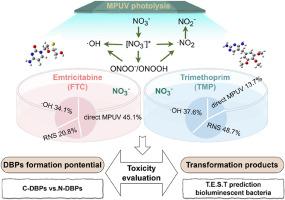硝酸盐存在下中压紫外线照射对药物污染物的增强降解:活性物质、毒性和DBPs的形成
IF 7.7
2区 环境科学与生态学
Q1 ENVIRONMENTAL SCIENCES
引用次数: 0
摘要
本研究采用中压UV/硝酸盐(MPUV/NO3−)工艺,比较研究了恩曲他滨(FTC)和甲氧苄啶(TMP)两种药物污染物(PCs)的降解动力学和机理、毒性变化以及消毒副产物(DBPs)的形成。碱性条件显著增强了FTC和TMP的直接MPUV光解作用,且FTC比TMP更敏感。在不同pH条件下,MPUV下2 mM NO3−的存在使FTC的降解率(kobs)提高了1.2 - 2.3倍,TMP的降解率提高了1.8 - 10.8倍,这主要归因于•OH和活性氮(RNS)的生成。在MPUV/NO3−处理下,FTC和TMP的菌落数均随ph的增加而降低。它们的菌落数最初随NO3−浓度的增加而增加,但在较高浓度时趋于稳定。结构差异导致不同的活性物质主导了FTC和TMP的降解。阴离子和腐植酸对FTC和TMP降解均有不同程度的抑制作用。基于LC/TOF/MS分析和DFT计算,我们确定了FTC中的胞嘧啶部分和TMP中的嘧啶环为易损位点,从而提出了降解途径。大多数FTC转化产物的发育毒性增加,但致突变性降低。硝化后的TMP产品表现出明显较高的发育毒性。抑制费氏弧菌实验表明,MPUV/NO3−工艺具有控制毒性的能力。MPUV/NO3−预处理提高了氯化后三氯硝基甲烷的生成。此外,氯胺化在控制DBPs形成及其相关毒性方面优于氯化。总之,本研究为多色紫外线照射下富硝酸盐废水中pc的转化途径和生态风险评估提供了重要的见解。本文章由计算机程序翻译,如有差异,请以英文原文为准。

Enhanced degradation of pharmaceutical contaminants by medium-pressure UV irradiation in the presence of nitrate: Reactive species, toxicity and DBPs formation
This study comparatively investigated the degradation kinetics and mechanisms, changes in toxicity, and formation of disinfection byproducts (DBPs) for two pharmaceutical contaminants (PCs), emtricitabine (FTC) and trimethoprim (TMP), using the medium-pressure UV/nitrate (MPUV/NO3−) process. Alkaline conditions markedly enhanced direct MPUV photolysis of both FTC and TMP, with FTC being more susceptible than TMP. The presence of 2 mM NO3− enhanced degradation rate (kobs) by 1.2–2.3-fold for FTC and 1.8–10.8-fold for TMP under MPUV across different pH conditions, attributed to •OH and reactive nitrogen species (RNS) generation. Under the MPUV/NO3− process, both FTC and TMP showed a decrease in kobs with increasing pH. Their kobs initially increased with NO3− concentration but plateaued at higher levels. Structural differences led to distinct reactive species dominating FTC and TMP degradation. Anions and humic acid inhibited FTC and TMP degradation to varying degrees. Based on LC/TOF/MS analysis and DFT calculations, the cytosine moiety in FTC and the pyrimidine ring in TMP were identified as vulnerable sites, leading to the proposed degradation pathways. Most FTC transformation products showed increased developmental toxicity but decreased mutagenicity. Nitrated TMP products exhibited notably higher developmental toxicity. The Vibrio fischeri inhibition assay showed that the MPUV/NO3− process had the ability to control toxicity. Pretreatment with MPUV/NO3− enhanced the formation of trichloronitromethane during post-chlorination. Additionally, chloramination outperforms chlorination in controlling DBPs formation and their associated toxicity. Overall, this study provides critical insights into the transformation pathways and ecological risk assessment of PCs in nitrate-rich wastewater under polychromatic UV irradiation.
求助全文
通过发布文献求助,成功后即可免费获取论文全文。
去求助
来源期刊

Environmental Research
环境科学-公共卫生、环境卫生与职业卫生
CiteScore
12.60
自引率
8.40%
发文量
2480
审稿时长
4.7 months
期刊介绍:
The Environmental Research journal presents a broad range of interdisciplinary research, focused on addressing worldwide environmental concerns and featuring innovative findings. Our publication strives to explore relevant anthropogenic issues across various environmental sectors, showcasing practical applications in real-life settings.
 求助内容:
求助内容: 应助结果提醒方式:
应助结果提醒方式:


